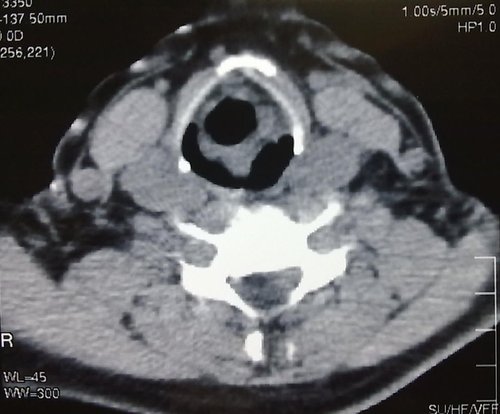A large epiglottic cyst causing upper airway obstruction
Abstract:
Cystic lesions involving larynx are fairly common. They constitute about 5% of benign laryngeal lesions. Majority of cysts arise from epiglottis. Lingual surface of epiglottis is commonly involved. These cysts have the potential to cause acute upper airway obstruction. This article discusses a patient who presented with a large epiglottic cyst with acute upper airway obstruction. This case is being reported not only for its rarity but also for management challenges it provides.
Introduction:
Studies reveal that cystic lesions involving larynx constitute about 5% 1 of benign laryngeal lesions. Majority of these laryngeal cyst originate from lingual surface of epiglottis 2. These cysts when they grow in size can cause acute upper airway obstruction. A plummy voice and biphasic stridor are common manifestations of this disorder 3.
Case Report:
42 years old female patient presented with change in voice – 4 years
Difficulty in breathing – 2 years
On examination:
Patient was in mild stridor.
A large cystic lesion arising from the left side of lingual surface of epiglottis occluding the laryngeal inlet could be visualized. Vocal cords found to be normally mobile.
CT scan neck: shows low density mass close to the tongue base.
If cyst is infected ring shaped contrast enhancement could be seen to occur. Sometimes air bubbles can be seen within the cyst. When air bubble is seen it should be differentiated from epiglottic abscess.
Management:
Since the top most priority is to secure the airway, tracheostomy was performed. Patient was then intubated via the tracheostome. The patient was then put in Rose position. Using Boyle Davis mouth gag the oral cavity was opened. Cyst was visualized arising from the left side of lingual surface of epiglottis. The same was removed using microscissors. Bleeding points were cauterized using bipolar diathermy cautery. Patient was decannulated two days later. Recovery was uneventful.
Discussion:
Studies reveal that more than 50% of cysts 4 involving larynx arise from epiglottis. DeSanto et al 4 classified cystic lesions of larynx into saccular and ductal types. Cysts of vallecula are known as vallceular cysts while cysts of epiglottis are supposed to be ductal type. Ductal type cysts are attributed due to obstruction to submucosal duct. Most adult epiglottic cysts commonly occur during the 6th decade of life 5. Asherson made minor changes to classification of laryngeal cystic lesions by adding one more category i.e Thyroid cartilage foramina cyst. Ofcourse this type of cyst was rather rare.
Epiglottic cysts in adult could be an incidental finding 7. Cysts of epiglottis are present in an inaccessible region of otopharynx. Removing these cysts could prove to be a difficult and challenging task. Laryngosopes used for microlaryngeal surgeries could bye pass the cystic lesion. It is always better to use Boyle Davis mouth gag which will expose epiglottis rather well. Cyst removal can be performed using microscissors / debriders / laser.
